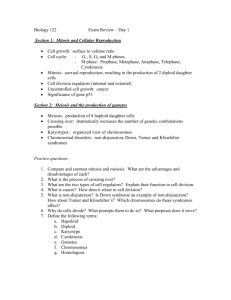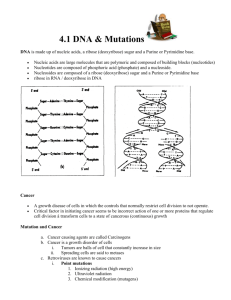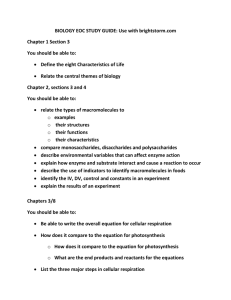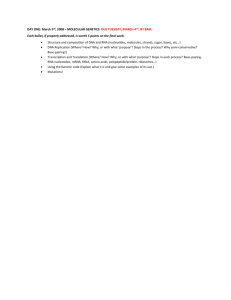exam_review_1 - Bonar Law Memorial
advertisement
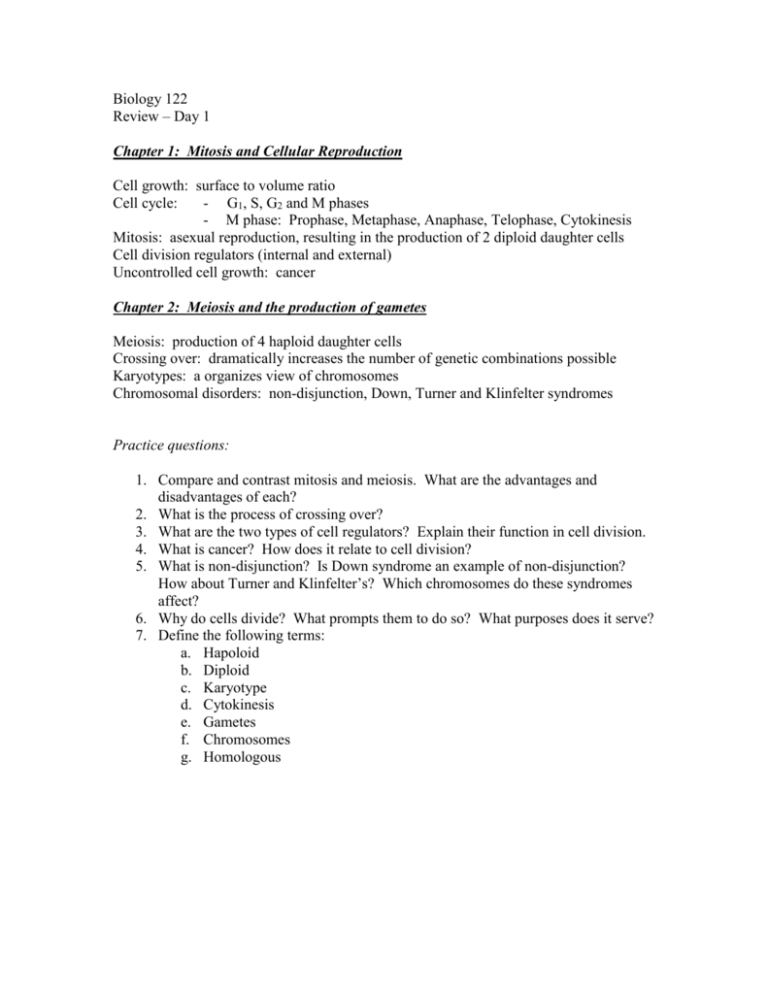
Biology 122 Review – Day 1 Chapter 1: Mitosis and Cellular Reproduction Cell growth: surface to volume ratio Cell cycle: - G1, S, G2 and M phases - M phase: Prophase, Metaphase, Anaphase, Telophase, Cytokinesis Mitosis: asexual reproduction, resulting in the production of 2 diploid daughter cells Cell division regulators (internal and external) Uncontrolled cell growth: cancer Chapter 2: Meiosis and the production of gametes Meiosis: production of 4 haploid daughter cells Crossing over: dramatically increases the number of genetic combinations possible Karyotypes: a organizes view of chromosomes Chromosomal disorders: non-disjunction, Down, Turner and Klinfelter syndromes Practice questions: 1. Compare and contrast mitosis and meiosis. What are the advantages and disadvantages of each? 2. What is the process of crossing over? 3. What are the two types of cell regulators? Explain their function in cell division. 4. What is cancer? How does it relate to cell division? 5. What is non-disjunction? Is Down syndrome an example of non-disjunction? How about Turner and Klinfelter’s? Which chromosomes do these syndromes affect? 6. Why do cells divide? What prompts them to do so? What purposes does it serve? 7. Define the following terms: a. Hapoloid b. Diploid c. Karyotype d. Cytokinesis e. Gametes f. Chromosomes g. Homologous Chapter 3: DNA Structure and Replication - DNA: made up of nucleotides Nucleotides: made up of deoxyribose sugar, phosphate group and nitrogenous base Nucleotides: 4 types (ACTG) Chagraff’s rule: A = T, C = G DNA replication (steps) Chapter 4: RNA, Protein Synthesis and Genetic Mutations - Genes: code for a sequence of amino acids called a polypeptide, which makes up a protein. - RNA: 3 types, ultimate purpose – create proteins! (new nucleotide: U instead of T) - RNA created by transcription - Be able to create complimentary DNA and RNA sequences using base-pairing principles. - Ribosomes: The cell’s protein synthesis factory - 2 types of mutations: Gene and chromosomal - Gene mutations are the result of point mutations (substitution / insertion / deletion) - Chromosomal mutations: deletion / duplication / inversion / translocation Practice questions: 1) What is base-pairing? What types of nucleotides would be likely to form a base pair? 2) For the following DNA strand, create a complimentary DNA strand, and a complimentary RNA strand: TACCGTAGTCAGTACGATAGCTAGCATAGCTA 3) Describe the process of creating a protein. 4) What is the purpose of proteins? 5) Describe the possible effects on a person of a mutation. 6) Are all mutations bad? Explain. 7) Compare and contrast gene mutations and point mutations. Is one worse? Is one more beneficial? 8) Define the following terms: a) Transformation f) bacteriophage b) complimentary DNA strands g) enzymes c) genes h) amino acids d) proteins i) transcription e) introns vs. exons j) codons
